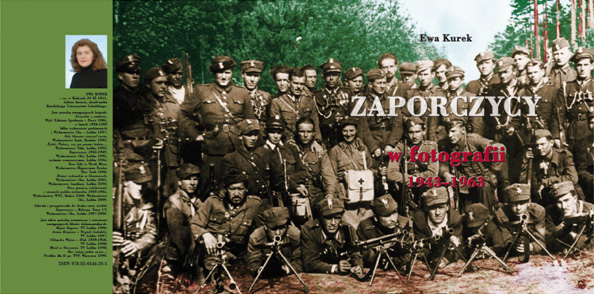ZOLNIERZE WYKLECI Freedom Fighters Kurek

Zaporczycy w Fotografii 1943-1963, by Ewa Kurek. 1995
The Zolnierze Wykleci: A Fascinating Photo-Album of Polish Guerrillas Who Fought Against the Nazis and Communists. Decades-Long Combat!
THE ‘ZAPORCZYCY’ [MAJOR ZAPORA’S MEN] IN PHOTOGRAPHS 1943-1963, is the title of this 2009 Polish-language book. It has a huge collection of photographs. The latter date in the title is not a misprint: One of the Polish guerrilla fighters (see below) actually continued fighting until 1963—nearly a full 20 years after the Red Army had first entered this part of Poland!
Besides the photographs, author Kurek provides a few pages of history of the guerrilla movements. The fighting organizations included the NSZ, ZWZ-AK, BCh, assorted smaller named units, and the post-WWII anti-Communist WiN. Towards the end of the book, she provides short alphabetically listed biographical paragraphs on the main Polish guerrilla fighters.
A SUMMARY OF EVENTS IN THE FORCED COMMUNIZATION OF POLAND
The Red Army, driving the Germans back after Stalingrad and Kursk, crossed the pre-WWII Polish-USSR frontier in early 1944. The AK (A. K.) came out in open warfare against the retreating Germans, and in support of the advancing Soviet armies, as part of their OPERACJA BURZA (Operation Tempest). The Soviet NKVD arrested and disarmed these Polish soldiers, and re-claimed the Kresy (Poland’s eastern half) for herself—supported the western Allied betrayal at 1943 Teheran.
Upon entering the Lublin area—the subject of this book, and territory recognized as “rightfully Poland’s” by all the world’s Allied powers—about mid-1944, everything repeated itself. The Soviets again arrested and disarmed Polish guerilla units who, shortly earlier, had been fighting the Germans on behalf of the advancing Red Army.
The Churchill-Roosevelt betrayal of Poland at Yalta gave a free hand to the Soviets to impose unilaterally their will upon prostrate Poland. The Soviet NKVD and the “Polish” U. B. (Bezpieka) arrested some 15,000 Poles in the Lublin area alone, already by mid-January 1945. Of these, some 9,100 were A. K. members, half of whom were deported to Siberia. (p. 11). Some of the guerrilla units managed to evade capture by disbanding and scattering. (p. 9).
What had been done by the German Nazis was now being repeated by the Russian Communists. Even Maidanek (Majdanek) became re-used by the Communists. They imprisoned A. K. officers there before deporting approximately 200 of them to Siberia. (p. 10).
A group of guerrillas led by Major “Zapora”, after whom this book is named, was active in the Lublin area after 1947, and they paid a heavy price for their sacrificial combat against the powerful Communist foe. In no sense was the Polish independentist guerrilla movement a “landlord’s army” as painted by Communist propaganda. Peasants alone constituted over 78% of “Zapora’s” guerrilla fighters. (p. 13).
After about 1947, the Communist terror had all but crushed all appreciable non-violent and violent resistance to the Soviet puppet state. Even so, the Communists murdered many of the captured guerrillas after that date, as evidenced the dates of their executions given in this work.
One of the most amazing things in this book is the fact that some guerrillas continued to fight for DECADES after any glimmer of hope for a free Poland had passed. Kurek (p. 119, 124) has a photo of A.K., NSZ., and W.i.N. guerrillas, including Andrzej Kiszka “”Leszczyna”, being captured in a bunker, near Bilgoraj, in 1961. Even more amazing is the case of Jozef Franczak “Lalek” of the A. K. (p. 119, 124). He had been fighting for Poland’s freedom since 1940, and his combat activities did not end until October 21, 1963. Wounded after his bunker had been surrounded that day near Lublin, and facing an uneven fight, he committed suicide. The Communists beheaded his body before turning it over to his sister. He was probably the last active soldier of Poland’s Second Republic.
To see a series of truncated reviews in a Category click on that Category:
- All reviews
- Anti-Christian Tendencies
- Anti-Polish Trends
- Censorship on Poles and Jews
- Communization of Poland
- Cultural Marxism
- German Guilt Dilution
- Holocaust Industry
- Interwar Polish-Jewish Relations
- Jewish Collaboration
- Jewish Economic Dominance
- Jews Antagonize Poland
- Jews Not Faultless
- Jews' Holocaust Dominates
- Jews' Holocaust Non-Special
- Nazi Crimes and Communist Crimes Were Equal
- Opinion-Forming Anti-Polonism
- Pogrom Mongering
- Poland in World War II
- Polish Jew-Rescue Ingratitude
- Polish Nationalism
- Polish Non-Complicity
- Polish-Ukrainian Relations
- Polokaust
- Premodern Poland
- Recent Polish-Jewish Relations
- The Decadent West
- The Jew as Other
- Understanding Nazi Germany
- Why Jews a "Problem"
- Zydokomuna